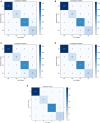DBPF-net: dual-branch structural feature extraction reinforcement network for ocular surface disease image classification
- PMID: 38239621
- PMCID: PMC10794599
- DOI: 10.3389/fmed.2023.1309097
DBPF-net: dual-branch structural feature extraction reinforcement network for ocular surface disease image classification
Abstract
Pterygium and subconjunctival hemorrhage are two common types of ocular surface diseases that can cause distress and anxiety in patients. In this study, 2855 ocular surface images were collected in four categories: normal ocular surface, subconjunctival hemorrhage, pterygium to be observed, and pterygium requiring surgery. We propose a diagnostic classification model for ocular surface diseases, dual-branch network reinforced by PFM block (DBPF-Net), which adopts the conformer model with two-branch architectural properties as the backbone of a four-way classification model for ocular surface diseases. In addition, we propose a block composed of a patch merging layer and a FReLU layer (PFM block) for extracting spatial structure features to further strengthen the feature extraction capability of the model. In practice, only the ocular surface images need to be input into the model to discriminate automatically between the disease categories. We also trained the VGG16, ResNet50, EfficientNetB7, and Conformer models, and evaluated and analyzed the results of all models on the test set. The main evaluation indicators were sensitivity, specificity, F1-score, area under the receiver operating characteristics curve (AUC), kappa coefficient, and accuracy. The accuracy and kappa coefficient of the proposed diagnostic model in several experiments were averaged at 0.9789 and 0.9681, respectively. The sensitivity, specificity, F1-score, and AUC were, respectively, 0.9723, 0.9836, 0.9688, and 0.9869 for diagnosing pterygium to be observed, and, respectively, 0.9210, 0.9905, 0.9292, and 0.9776 for diagnosing pterygium requiring surgery. The proposed method has high clinical reference value for recognizing these four types of ocular surface images.
Keywords: computer aided diagnosis; deep learning; pterygium; subconjunctival hemorrhage; visual recognition.
Copyright © 2024 Wan, Mao, Xi, Zhang, Wang and Yang.
Conflict of interest statement
The authors declare that the research was conducted in the absence of any commercial or financial relationships that could be construed as a potential conflict of interest.
Figures





References
LinkOut - more resources
Full Text Sources

